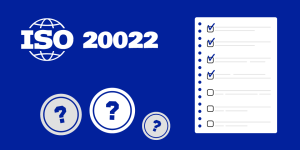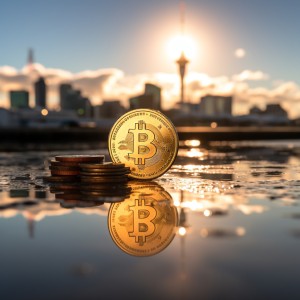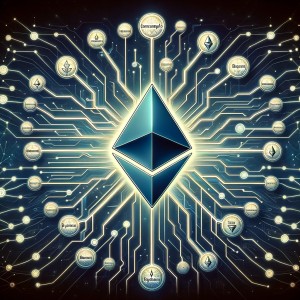As we navigate the constantly evolving digital landscape, some innovations stand out for their capacity to revolutionize our future. Among these, 5G networks and blockchain technology are distinctively impactful, each offering significant advancements within their spheres. 5G brings to the table its ultra-fast data transfer, low latency, and enhanced connectivity, traits that promise to redefine our experience of the internet. In parallel, blockchain offers a paradigm of security and transparency, creating an immutable environment where digital transactions and data exchanges can thrive with unparalleled trust.
Yet, it’s the intersection of these two revolutionary technologies that beckons a truly transformative wave, particularly in the realm of the Internet of Things (IoT). The 5G and blockchain combination will create a robust framework, empowering devices with rapid communication capabilities fortified by secure, transparent transactions. This coordination is not merely about enhancing what these technologies can do individually; it’s about exploring uncharted territories of a hyper-connected world.
Understanding 5G Technology
The emergence of 5G, the fifth-generation technology standard for broadband cellular networks, signifies a profound transformation in wireless communication. This technology substantially elevates network performance, ensuring a smoother user experience that transcends previous connectivity capabilities.
High data speeds
At the heart of 5G is its remarkable speed in data transmission, offering peak data rates potentially hitting 20 gigabits per second. This advancement means rapid downloads, high-quality streaming, and the seamless use of applications demanding substantial bandwidth, essentially relegating digital traffic jams to history.
Reduced latency
Another critical feature of 5G is its ultra-low latency, referring to the almost instantaneous time it takes for data to travel from one point to another. Expected to decrease to one millisecond, 5G’s responsiveness outperforms 4G by tenfold, a critical enhancement for technologies requiring real-time feedback, such as interactive gaming, telemedicine, and autonomous vehicles.
Enhanced connectivity
5G goes beyond speed, revolutionizing the connectivity it can sustain. With the capacity to support approximately one million devices within a single square kilometer, 5G lays the groundwork for unprecedented hyper-connectivity, catering to the demands of sophisticated smart ecosystems within cities, industries, and homes.
5G’s influence is notably pivotal for the Internet of Things (IoT). By enabling high-volume data transmission, robust connectivity, and minimal latency, 5G is the driving force behind a powerful IoT, allowing devices to interact and react in real-time. This capability is crucial for implementations across various sectors, including healthcare, transportation, and industrial manufacturing, where immediate data exchange and actions are essential.
The deployment of 5G networks is underway globally, with diverse stages of adoption. Urban areas are experiencing the initial benefits, with full coverage being the ultimate goal that still requires considerable work, particularly in less developed regions. Telecom giants are heavily investing in the necessary infrastructure, and there is ongoing global cooperation for standardizing technology and spectrum use, ensuring a unified 5G experience worldwide.
Exploring Blockchain Technology
Beyond the digital currency realm, blockchain technology presents a revolutionary approach to data security and transactional transparency, fundamentally transforming how information can be shared and stored.
The cornerstone of blockchain’s allure lies in its decentralized framework. Without a central authority, the system offers heightened security and resilience, storing data across a network of computers, thereby challenging hackers aiming to manipulate or alter information. Each unit of data, or ‘block,’ forms a securely linked chain with its predecessors, ensuring an unchangeable, chronological record.
Blockchain introduces smart contracts, representing agreements whose conditions are encoded and executed automatically. This characteristic simplifies, solidifies, and automates digital interactions. Additionally, blockchain operates on consensus protocols, a crucial element that requires network participants to agree unanimously on each transaction’s authenticity, thus preventing potential fraud and duplicity.
The surge of IoT has ushered in an urgent need to secure vast data volumes and ensure their reliability. Integrating blockchain with IoT addresses these challenges by solidifying device authentication, securing communications, and streamlining machine-to-machine interactions. By enlisting each IoT device on a blockchain platform, it creates a foolproof, unalterable log of its lifecycle and operations. This meticulousness in data recording is indispensable in sectors where the slightest data discrepancy can lead to severe failures or security compromises.
The amalgamation of 5G and Blockchain
The amalgamation of 5G and blockchain technologies represents a convergence of two potent forces in the digital realm. High-speed data transmission meets secure, transparent record-keeping, offering an unparalleled amalgamation poised to reshape how we interact with the digital world.
In the Internet of Things (IoT), ensuring the authenticity of devices is paramount. Blockchain provides an immutable ledger for registering and verifying the identity of each IoT device. This feature safeguards against unauthorized access or malicious impersonation, enhancing the overall security of IoT networks.
Blockchain’s cryptographic principles and smart contracts facilitate secure, tamper-resistant communication between IoT devices. Data exchanged within these channels remains confidential and intact, minimizing vulnerabilities to eavesdropping and cyberattacks.
By integrating blockchain with 5G-powered IoT, devices gain the capacity for autonomous decision-making in a decentralized fashion. This autonomy not only reduces latency but also enables real-time, trust-based transactions between devices without the need for intermediaries.
Amplifying Blockchain through 5G Capabilities
Blockchain networks benefit from significantly increased throughput when operating within 5G infrastructure; this means that it can process more transactions and data in a shorter time frame. As 5G empowers devices with faster data transfer rates, the blockchain network can match this pace, resulting in enhanced efficiency.
To address the challenge of scalability, 5G-powered blockchain systems can integrate layer-2 solutions. These solutions enable off-chain transactions and reduce the strain on the main blockchain, ensuring smooth operations even as the network scales to accommodate a more significant number of transactions.
Leveraging 5G to Broaden Blockchain’s Horizons
The introduction of 5G networks encourages wider participation in blockchain ecosystems. Individuals and entities in remote or underserved regions can more readily access blockchain networks, fostering node diversity and enhancing the overall network resilience and security.
5G’s capabilities also open the door to potentially reducing block times within blockchain networks. Faster data transmission and consensus mechanisms can expedite the validation of transactions, reducing confirmation times and making blockchain more conducive to real-time applications and microtransactions.
The harmonious integration of 5G and blockchain technologies is not merely a matter of technological advancement; it represents a profound shift in how we approach digital trust, security, and connectivity, promising a future where our digital interactions are not only faster but also more secure and transparent than ever before.
Real-world Applications and Opportunities
Internet of Skills (IoS)
The fusion of 5G and blockchain technologies sets the stage for the Internet of Skills (IoS), a paradigm-shifting concept poised to revolutionize remote work and the sharing of expertise. IoS harnesses the power of high-speed, low-latency 5G networks and the security of blockchain to enable specialists to perform tasks remotely through immersive technologies.
IoS applications are as diverse as they are promising. From healthcare to engineering, IoS allows professionals to conduct intricate procedures and offer specialized services from a distance. For example, a surgeon can perform a complex operation while being miles away from the operating table, guided by real-time feedback and high-resolution visuals. The low latency of 5G ensures that actions and responses occur in real-time, creating a responsive and immersive experience.
Industrial Automation
The marriage of 5G and blockchain is a catalyst for the evolution of industrial automation. Traditional sectors such as manufacturing, agriculture, and mining are undergoing profound transformations driven by the integration of IoT devices powered by 5G connectivity.
In manufacturing, machines equipped with IoT sensors communicate seamlessly over 5G networks, enabling real-time monitoring and predictive maintenance. This results in increased efficiency, reduced downtime, and cost savings. In agriculture, smart farming techniques utilize IoT sensors to monitor soil conditions, crop health, and weather data, optimizing yields and minimizing resource waste. In mining, autonomous vehicles and drilling equipment leverage 5G connectivity for remote operation, enhancing safety and productivity.
Smart Ecosystems
The collaboration between 5G and blockchain is at the heart of the smart ecosystem revolution. Smart cities are harnessing this synergy to optimize energy management, transportation systems, and urban infrastructure. In logistics, real-time tracking and monitoring of shipments are made possible, ensuring efficient supply chain management. Furthermore, environmental monitoring benefits from IoT devices connected via 5G, delivering precise data on air quality, water quality, and climate conditions.
These smart ecosystems thrive on the speed and reliability of 5G networks, while blockchain guarantees data integrity, security, and transparency. The result is an interconnected environment where data-driven decision-making and resource optimization become the norm, making cities more sustainable, logistics more efficient, and our world more resilient to environmental challenges.
Supply Chain Transparency
One of the most immediate and impactful applications of 5G and blockchain integration is in supply chain transparency. Industries are using this technology combination to create unassailable traceability and accountability in the movement of goods.
Blockchain’s immutable ledger records every step in a product’s journey, from raw materials to final delivery. 5G ensures that data is transmitted in real time, providing consumers and stakeholders with instant access to the history and authenticity of products. This transparency is invaluable for ensuring the authenticity of goods, detecting fraud, and achieving sustainability goals by tracking the origins of products and their environmental impact.
Challenges and Considerations
Scalability Hurdles
The rapid growth of IoT devices and the corresponding surge in transactions present a formidable scalability challenge. As 5G networks enable more devices to connect and interact, blockchain networks must evolve to accommodate the increased load. Ensuring that blockchain can process and verify transactions from a vast array of IoT devices on time is a complex task.
To mitigate scalability issues, blockchain developers are actively exploring innovations. Techniques like sharding and layer-two solutions are being implemented to enhance the throughput of blockchain networks. These innovations aim to strike a balance between decentralization and scalability, allowing blockchain to support the demands of a hyper-connected world.
Security Concerns
While blockchain is known for its security, it is not immune to vulnerabilities. Smart contract bugs, 51% attacks, and potential quantum computing threats are among the concerns. Mitigating these risks requires continuous development of security protocols, thorough code audits, and ongoing research to stay ahead of emerging threats.
Blockchain systems face the challenge of maintaining equilibrium among decentralization, security, and scalability. Achieving one goal often comes at the expense of the others. Striking the right balance is a complex task, and decisions regarding network design, consensus mechanisms, and data storage must carefully consider this trilemma to ensure a robust and sustainable blockchain ecosystem.
Data Management Complexities
Not all data generated by IoT devices can be stored directly on the blockchain due to size and cost constraints. Ensuring the integrity of off-chain data becomes crucial. Decentralized storage solutions like InterPlanetary File System (IPFS) are being explored to securely store data off-chain while maintaining cryptographic proofs on-chain to verify its authenticity.
The immutability of blockchain records is a double-edged sword. While it ensures data integrity, it also means that errors or inaccuracies, once recorded, are challenging to rectify. Implementing governance models and mechanisms for dispute resolution within blockchain networks becomes essential to manage data inaccuracies effectively.
Legislative and Ethical Implications
The collection, storage, and sharing of data within 5G-powered blockchain systems raise significant data privacy concerns. Striking a balance between enabling innovation and safeguarding individual privacy is a pressing challenge. Regulations and frameworks that address data protection and user consent are evolving and must be navigated carefully.
As 5G and blockchain technologies advance, it is imperative to consider their impact on society. Bridging the digital divide to ensure equitable access to these innovations is essential. Additionally, understanding and mitigating potential societal impacts, such as job displacement due to automation, are ethical considerations that must be addressed as these technologies continue to evolve.
Conclusion
The convergence of 5G and blockchain technology presents a remarkable intersection of innovations that foreshadow a future where connectivity, security, and transparency blend to redefine the digital landscape. With 5G networks delivering unprecedented speeds and real-time capabilities, blockchain establishes the bedrock of trust and data integrity. Together, they stand poised to revolutionize industries, empower individuals, and transform the way people engage in work, transactions, and connectivity. Nevertheless, as we navigate this transformative journey, it remains imperative to address challenges related to scalability, security, data management, and ethical considerations with meticulous attention. By embracing emerging trends, establishing global standards, and emphasizing inclusivity, we can chart a course toward a future where the coordination of 5G and blockchain ushers in hitherto unimagined economic, social, and technological paradigms, promising a world of endless opportunities.




